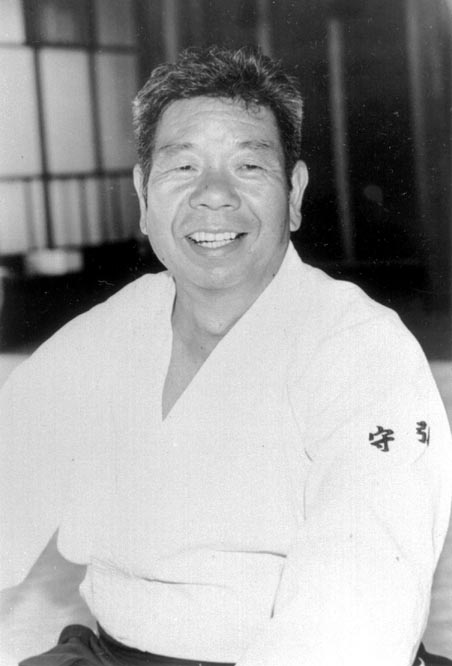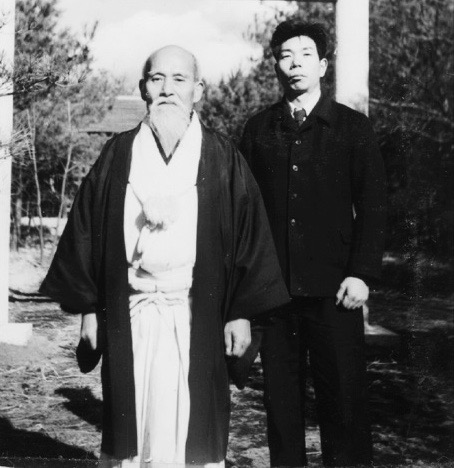In an interview appearing in Aikido Journal, O-Sensei explains that he was involved in training for the war effort in Japan.
Would you please elaborate on his activities?

After the war, O-Sensei had a great deal of leisure time compared with before the war. In the pre-war years, he kept busy traveling all around Japan teaching at military schools. This work ended with the conclusion of the war. No longer able to do these things, O-Sensei began to farm, growing rice and vegetables. It was at that time that I became a pupil. O-Sensei began to concentrate on the study of techniques. He was able to study Aikido in a slow, deliberate manner. That’s why O-Sensei used to say that his post-war budo is the true Aikido.
O-Sensei was deeply effected by the terrible consequences of the war. This appears to have caused him to reevaluate his idea of the purpose of budo during his years at Iwama immediately after the war. Would you comment on these changes?
O-Sensei taught at the Army and Naval Academies, the Toyama School (a police academy), the Spy School, and so forth. He also trained people associated with the military. He taught instructors and martial art teachers at the Army and Naval Academies. There were quite a number of requests for instruction; a large number of high-ranking officers came to Hombu Dojo. Such stories as those are true. I heard many after the war ended. Many from among O-Sensei’s followers who were my seniors were involved in the war. Finally, after the war ended, the American military trials took place. Many of O-Sensei’s followers were involved in these trials.
However, since O-Sensei would always talk about the “Kamisama” (deities) and taught love and harmony, the American authorities said nothing. Many of O-Sensei’s followers were found guilty at the trials. Since only O-Sensei’s teachings were proper, nothing happened to him. And, when I became a student immediately after the war, O-Sensei traveled to the largest American military base in Yokohama to demonstrate his art. Again, nothing was said. It was OK.
In 1948, the Japanese government took the “bu” (martial) out of “budo” and the “bu” out of “Aiki Budo.” Thus, the Aikikai Foundation came into being and there was no longer an “Aiki Budo.” The Aikikai Foundation received permission from the government form the beginning and many good budo (martial arts) were saved. After that O-Sensei began to study techniques in earnest. O-Sensei used to say that the true Aikido came after the war. There were many of O-Sensei’s former students who returned and began teaching Aikido. However, there training was a little different from outs. Whatever they did, swinging the sword, etc, was rather severe.
When O-Sensei would do suwari waza (seated techniques), it would be suwari waza day in and day out. When he would begin ryote dori training, we would practice ryote dori every day. And O-Sensei also studied by himself. It was at that time that I became a student. I was taught everything. I was very lucky.
It seems that O-Sensei had some exposure to Chinese martial arts during a visit to Peking. What effect did this have on his view of budo?
O-Sensei went to Mongolia, to China on business and for religious matters. I understand he did some research on martial arts while there. The same thing occurred with Chinese martial arts as when O-Sensei studied Japanese martial arts; his spirit became part of the martial art. So, for example, when O-Sensei did the Kashima sword style, it became the Aiki sword. His way of using ki and turning his hips were completely different. Or, when he did a Daito-ryu technique it ended up becoming Aikido. The way of using ki, kokyu (breathing), tai sabaki (body blending) are not a part of Daito-ryu. They are unique to Aikido. O-Sensei did indeed study Daito-ryu. Daito-ryu was an important source of Aikido. When O-Sensei did them, the Daito-ryu techniques became totally different. Daito-ryu people say that Aikido is Daito-ryu. “Nonsense, that’s wrong,” O-Sensei would say in response. On two or three occasions, well-known Daito-ryu Senseis have come to my place and their art was completely different. They cannot do tai sabaki, nor do they have kokyu. So, although there was a time when O-Sensei practiced Daito-ryu techniques, they were transformed in his Aikido. Tai sabaki, the method of unifying ki, and kokyuho were added. It is not Daito-ryu at all. Daito-ryu people may say Aikido is Daito-ryu, but Daito-ryu is completely different. Aikido is Aikido.
However, since O-Sensei would always talk about the “Kamisama” (deities) and taught love and harmony, the American authorities said nothing. Many of O-Sensei’s followers were found guilty at the trials. Since only O-Sensei’s teachings were proper, nothing happened to him. And, when I became a student immediately after the war, O-Sensei traveled to the largest American military base in Yokohama to demonstrate his art. Again, nothing was said. It was OK.
About Chinese martial arts… O-Sensei did not speak ill of other martial arts. He did not criticize any martial art whatever, “Ah, good! That’s a good style… that’s a good style,” he’d say. O-Sensei never spoke ill of other’s budo. So, he said the Chinese martial arts were good arts, too. But they have no relationship to Aikido.
Aikido is a budo which allows an individual to express himself in a unique way. In what direction are you personally interested in taking your art?
As for my view of Aikido, I would like to unify the different styles of Aikido existing today. Nowadays, many people are teaching Aikido, but everyone is doing different things. Sometimes, we teach basics in opposite ways. So, we too of course, are still weak. The teachers at Hombu Dojo, too, all have different ways of teaching, but, somehow, I would like to make them into one… into one serious, true Aikido. That is my wish. Consequently, I wrote a series of books. In those books, I wrote down the things O-Sensei said and published photographs of O-Sensei. Those photos are the evidence that our style reflects O-Sensei’s style. if people who are learning cannot understand the various different styles of Aikido, that’s unfortunate. Wherever one goes, there are different techniques and different styles of teaching. Also at Hombu Dojo, the instructors all have different styles of teaching. It’s unfortunate because when people come from the country to Hombu Dojo and see all the different teaching methods they become puzzled. That’s the present state… if you take Kokyu from Aiki, it’s like taking “power” out of Sumo wrestling. Kokyu in Aiki is like power in Sumo. Sumo without power is worse than a dance. Aikido without kokyu is even worse than that.
About Chinese martial arts… O-Sensei did not speak ill of other martial arts. He did not criticize any martial art whatever, “Ah, good! That’s a good style… that’s a good style,” he’d say. O-Sensei never spoke ill of other’s budo. So, he said the Chinese martial arts were good arts, too. But they have no relationship to Aikido.
I feel that it is all right if I don’t become famous. Since I have a job, it doesn’t matter if I don’t earn a lot of money. I merely wish others to understand O-Sensei’s techniques. So I am fortunate. I’m not greedy. I don’t think about becoming famous in martial arts or becoming rich. I don’t think about such things at all. It’s enough that everyone be able to understand O-Sensei’s technique. That is my only wish.
Thank you very much, Sensei.
The preceding interview was conducted in October, 1974 at Stanford University.













On Aikido and Chinese arts:
https://www.amazon.com/Aikido-Chinese-Martial-Arts-Fundamental/dp/0870409344